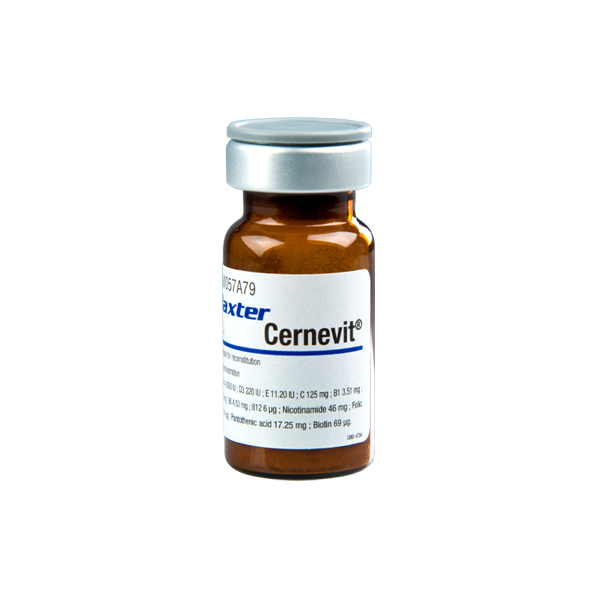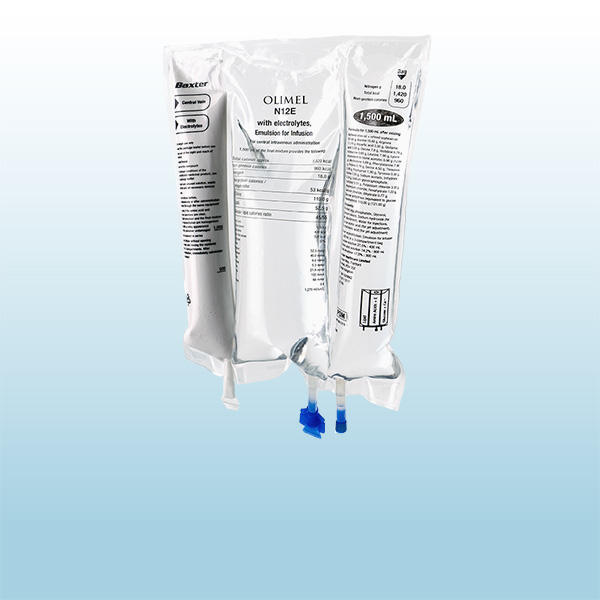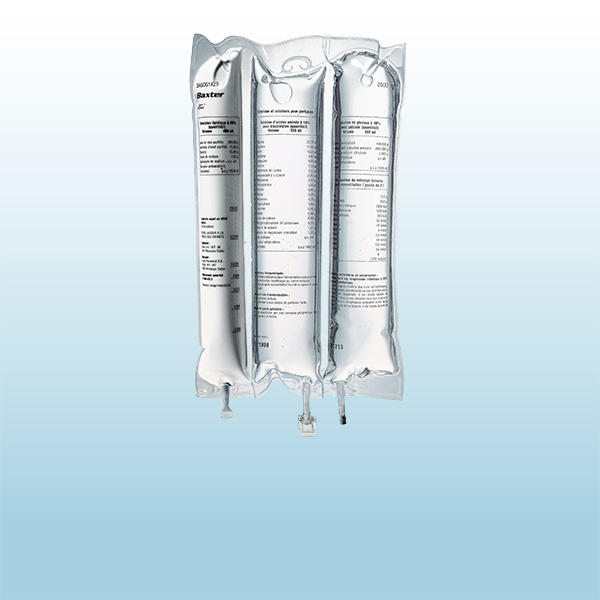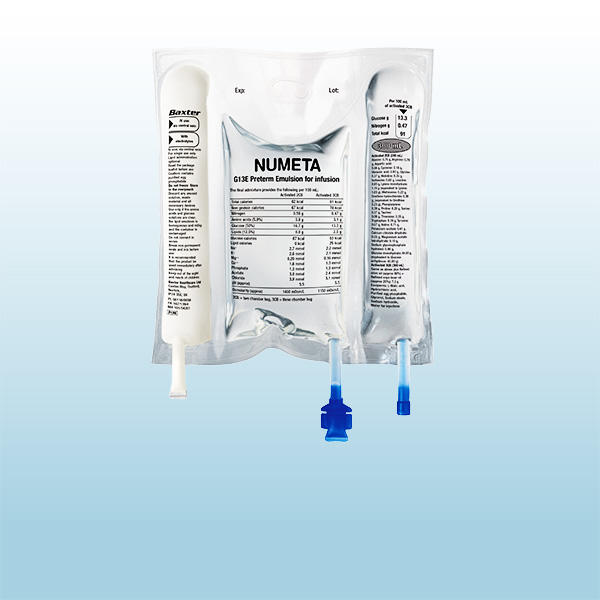Important safety information
CERNEVIT
This abbreviated summary of product characteristics (SPC) is intended for international use. Please note that it may differ from the licensed SPC in the country where you are practicing. Therefore, please always consult your country-specific SPC or package leaflet.
CERNEVIT, powder for solution for injection or infusion
QUALITATIVE AND QUANTITATIVE COMPOSITION
One vial (5 ml) contains : Retinol (Vitamin A) in the form of retinol palmitate 3500 IU; Cholecalciferol (Vitamin D3) 220.000 IU; Alpha-tocopherol (Vitamin E) 11.200 IU; corresponding to DL alpha-tocopherol quantity 10.200 mg; Ascorbic acid (Vitamin C) 125.000 mg; Thiamine (Vitamin B1) 3.510 mg; in the form of cocarboxylase tetrahydrate 5.800 mg; Riboflavin (Vitamin B2) 4.140 mg; in the form of riboflavin sodium phosphate dehydrate 5.670 mg; Pyridoxine (Vitamin B6) 4.530 mg; in the form of pyridoxine hydrochloride 5.500 mg; Cyanocobalamin (Vitamin B12) 0.006 mg; Folic acid (Vitamin B9) 0.414 mg; Pantothenic acid (Vitamin B5) 17.250 mg; in the form of dexpanthenol 16.150 mg; Biotin (Vitamin B8) 0.069 mg; Nicotinamide (Vitamin PP) 46.000 mg
Excipients: Glycine, glycocholic acid, soya lecithin, sodium hydroxide, hydrochloric acid.
Therapeutic indications:
Vitamin supplementation in patients receiving parenteral nutrition. Only for adults and children aged over 11 years of age.
Posology and method of administration: Adults, adolescents and children aged over 11 years of age:1 vial per day. Intravenous route exclusively. Elderly: No adjustment of the adult dosage due to age alone is necessarily needed; however clinicians should be aware of the increased risk of conditions that may affect posology in this population for example multiple diseases, polypharmacy, malnutrition status, impaired metabolism, and in particular hepatic, renal and cardiac disease resulting in a reduction of dosing or frequency. Renal and hepatic impairment: Individualized vitamin supplementation needs to be considered to maintain adequate vitamin levels and to prevent vitamin toxicity.
Method of administration: After reconstitution, administer by slow intravenous injection (at least 10 minutes) or infusion in a solution of 5% glucose or 0.9% sodium chloride solution for infusion. Administration can be continued throughout the period of parenteral nutrition. CERNEVIT may be included in the composition of nutritive admixtures combining carbohydrates, lipids, amino acids, and electrolytes, provided that compatibility and stability have been previously confirmed for each nutritive admixture, used.
Contraindications: Cernevit must not be used in: hypersensitivity to the active substances, especially vitamin B1 or to any of the excipients, including soy protein/products (lecithin in mixed micelle is soy-derived) or peanut protein/products, hypervitaminosis from any vitamin contained in this formulation.
Special warnings and special precautions for use:
Warnings: Hypersensitivity Reactions: Mild to severe systemic hypersensitivity reactions to the constituents of CERNEVIT have been reported (including vitamins B1, B2, B12, folic acid and soya lecithin). Cross-allergic reactions between soybean and peanut proteins have been observed. The infusion or injection must be stopped immediately if signs or symptoms of a hypersensitivity reaction develop. Vitamin Toxicity: The patient’s clinical status and blood vitamin concentrations should be monitored to avoid overdose and toxic effects, especially with vitamins A, D and E, and in particular in patients who receive additional vitamins from other sources or use other agents that increase the risk of vitamin toxicity.
Refeeding Syndrome in Patients Receiving Parenteral Nutrition
Refeeding severely undernourished patients may result in refeeding syndrome that is characterized by the shift of potassium, phosphorus, and magnesium intracellularly as the patient becomes anabolic. Thiamine deficiency and fluid retention may also develop. Careful monitoring and slowly increasing nutrient intakes while avoiding overfeeding can prevent these complications. Should nutrient deficiencies occur, appropriate supplementation may be warranted.
Precipitates in Patients Receiving Parenteral Nutrition
Pulmonary vascular precipitates have been reported in patients receiving parenteral
nutrition. In some cases, fatal outcomes have occurred. Excessive addition of calcium and phosphate increases the risk of the formation of calcium phosphate precipitates. Precipitates have been reported even in the absence of phosphate salt in the solution. Precipitation distal to the in-line filter and suspected precipitate formation in the blood stream have also been reported.
Precautions: Hepatic Effects: Monitoring of liver function parameters is recommended in patients receiving CERNEVIT. Particularly close monitoring is recommended in patients with hepatic jaundice or other evidence of cholestasis. In patients receiving CERNEVIT, instances of liver enzyme increases have been reported, including isolated alanine aminotransferase (ALT) increases in patients with inflammatory bowel disease In addition, an increase in bile acid levels (total and individual bile acids including glycocholic acid) have been reported in patients receiving CERNEVIT. Due to the presence of glycocholic acid, repeated and prolonged administration in patients with hepatic jaundice or significant laboratory cholestasis requires careful monitoring of liver function. Hepatobiliary disorders including cholestasis, hepatic steatosis, fibrosis and cirrhosis, possibly leading to hepatic failure, as well as cholecystitis and cholelithiasis are known to develop in some patients on parenteral nutrition (including vitamin supplemented parenteral nutrition). The etiology of these disorders is thought to be multifactorial and may differ between patients. Patients developing abnormal laboratory parameters or other signs of hepatobiliary disorders should be assessed early by a clinician knowledgeable in liver diseases in order to identify possible causative and contributory factors, and possible therapeutic and prophylactic interventions.
Use in Patients with Impaired Hepatic Function: Patients with hepatic impairment may need individualized vitamin supplementation. Particular attention should be placed on preventing vitamin A toxicity, because the presence of liver disease is associated with increased susceptibility to vitamin A toxicity, in particular in combination with chronic excessive alcohol consumption Use in Patients with Impaired Renal Function: Patients with renal impairment may need individualized vitamin supplementation, depending on the degree of renal impairment and the presence of concomitant medical conditions. In patients with severe renal impairment, particular attention should be placed on maintaining adequate vitamin D status and preventing vitamin A toxicity.
General Monitoring: The total vitamin amounts from all sources such as nutritional sources, other vitamin supplements, or medications that contain vitamins as inactive ingredients should be considered. The patient’s clinical status and vitamin levels should be monitored to ensure maintenance of adequate levels. It should be taken into account that some vitamins, especially A, B2, and B6 are sensitive to ultraviolet light (e.g., direct or indirect sun light). In addition, loss of vitamins A, B1, C, and E may increase with higher levels of oxygen in the solution. These factors should be considered if adequate vitamin levels are not achieved. Patients receiving parenteral multivitamins as the only source of vitamins for extended periods of time should be monitored for adequate supplementation, for example: Vitamin A in patients with pressure ulcers, wounds, burns, short bowel syndrome or cystic fibrosis, Vitamin B1 in dialysis patients, Vitamin B2 in cancer patients, Vitamin B6 in patients with renal impairment, Individual vitamins whose requirements may be increased due to interactions with other medicines.Deficiency of one or more vitamins must be corrected by specific supplementation. CERNEVIT does not contain vitamin K, which should be administered separately if necessary. Use in Patients with Vitamin B12 Deficiency: Evaluation of vitamin B12 status is recommended before starting supplementation with CERNEVIT in patients at risk for vitamin B12 deficiency and/or when supplementation over several weeks is planned. After several days of administration, both the individual amounts of cyanocobalamin (vitamin B12) and folic acid in CERNEVIT may be sufficient to result in an increase in red blood cell count, reticulocyte count, and hemoglobin values in some patients with vitamin B12 deficiency-associated megaloblastic anemia. This may be masking an existing vitamin B12 deficiency which requires higher doses of cyanocobalamin than provided in CERNEVIT. When interpreting levels of vitamin B12, it should be taken into account that recent intake of vitamin B12 may result in normal levels despite a tissue deficiency. Laboratory Test Interferences: Biotin may interfere with laboratory tests that are based on a biotin/streptavidin interaction, leading to either falsely decreased or falsely increased test results, depending on the assay. Ascorbic acid may interfere with urine and blood glucose testing systems Geriatric Use: In general, dosage adjustments for an elderly patient should be considered (reducing the dose and/or extending the dosing intervals) reflecting the greater frequency of decreased hepatic, renal, or cardiac function, and of concomitant disease or drug therapy. Sodium content: CERNEVIT contains 24 mg sodium (1 mmoL) per vial. This should be taken into consideration if patients are on a controlled sodium diet. Compatibility must be tested before mixing with other solutions for infusion and, specifically, when CERNEVIT is added to bags containing binary parenteral nutrition mixtures combining glucose, electrolytes, and an amino acid solution, together with ternary mixtures combining glucose, electrolytes and amino acid solutions and lipids
Fertility, Pregnancy, and Lactation: Pregnancy: No safety data are available for CERNEVIT administered during pregnancy or in breastfeeding women. This medicinal product may be prescribed during pregnancy if required, providing the indication and dosages are observed in order to avoid vitamin overdose. Lactation Use is not recommended during breastfeeding because of the risk of vitamin A overdose in the neonate. There are no adequate data from the use of Cernevit with regards to fertility in male or female patients.
Undesirable effects: Unknown frequency: Immune system disorders: Systemic hypersensitivity reactions with manifestations such as respiratory distress, chest discomfort, throat tightness, urticaria, rash, erythema, epigastric discomfort, as well as cardiac arrest with fatal outcome. Metabolism and nutrition disorders: Vit A increased. Retinol binding protein increased. Nervous system disorders: Dysgueusia. Cardiac disorders: Tachycardia. Respiratory, thoracic and mediastinal disorders: Tachypnea. Gastrointestinal disorders: Diarrhoea. Hepatobiliary disorders: Transaminases increased, isolated alanine aminotransferase increase, glutamate dehydrogenase increased, blood alkaline phosphatase increased, bile acids increased, gamma-glutamyltransferase increased. Skin and subcutaneous tissue disorders: Pruritus. General disorders: Pirexia, generalized aching, infusion site reactions.
Uncommon: Nausea. Common:Injection/Infusion site pain.
Overdose
Acute or chronic overdose of vitamins (in particular A, B6, D, and E) can cause symptomatic hypervitaminosis. Treatment of vitamin overdose usually consists of withdrawal of the vitamin and other measures as clinically indicated.
PHARMACEUTICAL PARTICULARS: Instructions for use and handling CERNEVIT:
Using a syringe, inject 5 ml of water for injections or 5% glucose solution or 0.9% sodium chloride solution into the vial. Mix gently to dissolve the powder. The obtained solution is yellow-orange in color. Medicinal products subject to medical prescription.
For more information, please check full SPC.
Date of preparation: Apr 2020
Cernevit SmPC










